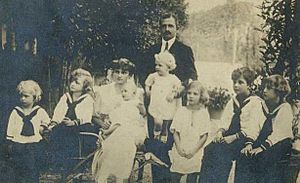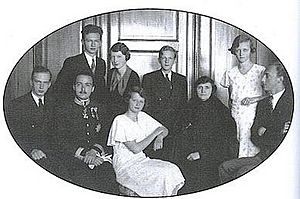Zita of Bourbon-Parma facts for kids
Quick facts for kids Zita of Bourbon-Parma |
|||||
|---|---|---|---|---|---|
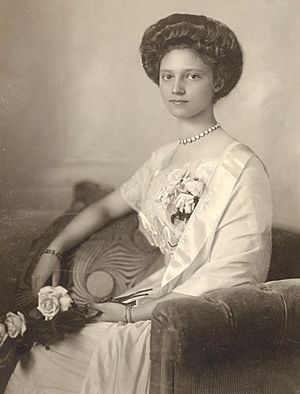 |
|||||
| Empress consort of Austria Queen consort of Hungary |
|||||
| Tenure | 21 November 1916 – 11 November 1918 | ||||
| Coronation | 30 December 1916 | ||||
| Born | 9 May 1892 Villa Borbone, Tuscany, Italy |
||||
| Died | 14 March 1989 (aged 96) Zizers, Grisons, Switzerland |
||||
| Burial | 1 April 1989
|
||||
| Spouse | |||||
| Issue |
|
||||
|
|||||
| House | Bourbon-Parma | ||||
| Father | Robert I, Duke of Parma | ||||
| Mother | Infanta Maria Antonia of Portugal | ||||
| Signature | |||||
Zita of Bourbon-Parma (born May 9, 1892 – died March 14, 1989) was a princess who became the wife of Charles. He was the last ruler of Austria-Hungary. This made Zita the last Empress of Austria and Queen of Hungary. She was a very religious Catholic. Later, she was even called a Servant of God by Pope Benedict XVI.
Zita was the seventeenth child of Robert I, Duke of Parma, who had lost his royal position. Her mother was Infanta Maria Antonia of Portugal. Zita married Archduke Charles of Austria in 1911. Charles became the next in line to the throne in 1914. This happened after his uncle, Archduke Franz Ferdinand of Austria, was assassinated. Charles became emperor in 1916 when the old emperor, Franz Joseph I, died.
After World War I ended in 1918, the royal family, known as the Habsburgs, lost their power. The empire was broken up into new countries like Austria, Hungary, and Czechoslovakia. Other parts joined neighboring countries. Charles and Zita had to leave for Switzerland. After attempts to regain power in Hungary failed, they were sent to Madeira by other countries. Charles died there in 1922. Zita became a widow at 29 and never remarried. She raised her eight children and became a symbol for the exiled royal family.
Contents
Early Life and Education
Princess Zita of Bourbon-Parma was born on May 9, 1892, in Italy. Her unusual name, Zita, came from a popular Italian saint. She was the fifth child of Robert I, Duke of Parma. Her father had lost his throne in 1859. Zita was one of 24 children her father had from two marriages.
The family moved between their homes in Italy and Austria. Zita and her siblings learned to speak many languages, including Italian, French, German, Spanish, Portuguese, and English.
At age ten, Zita went to a strict boarding school in Bavaria. There, she focused on studies and religious lessons. After her father died in 1907, she went to a convent on the Isle of Wight to finish her education. Zita and her siblings were raised as strong Catholics. They often helped the poor by giving out food, clothes, and medicine. For a while, Zita even thought about becoming a nun.
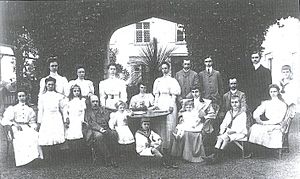
Marriage and Family Life
Near Zita's home in Austria lived Archduke Charles of Austria-Este. He was second in line to the Austrian throne. Charles and Zita had met as children but reconnected in 1909. Charles needed to marry someone from a royal family. Zita had a perfect royal background.
Charles visited Zita's home and asked her to marry him. Their engagement was announced on June 13, 1911. Zita later said she worried about the future of the Austrian Empire. Charles and Zita were married on October 21, 1911. The 81-year-old Emperor Franz Joseph, Charles's great-uncle, attended the wedding. He was happy to see Charles make a good marriage.
Zita soon became pregnant. Their first son, Otto, was born in November 1912. They would have seven more children in the next ten years.
Wife of the Heir to the Throne
Charles was in his twenties and did not expect to become emperor soon. This changed on June 28, 1914. His uncle, Archduke Franz Ferdinand, and his wife were assassinated in Sarajevo. Charles and Zita heard the news by telegram. Zita remembered Charles's face turning white.
This event led to World War I. Charles became a general in the Austrian army. The war was hard for Zita. Some of her brothers fought on opposite sides. Her home country, Italy, also joined the war against Austria. Because of this, some people spread rumors about Zita being "Italian."
At the request of Emperor Franz Joseph, Zita and her children moved to Schönbrunn Palace. Zita spent a lot of time with the old Emperor. He shared his worries about the future with her. Emperor Franz Joseph died on November 21, 1916.
Empress and Queen
Charles and Zita were crowned in Budapest on December 30, 1916. They kept the celebrations short because of the ongoing war. Charles was often away from Vienna, so he had a phone line installed to talk to Zita daily. Zita had some influence on her husband. She quietly attended meetings with the Prime Minister and military briefings. She was very interested in helping people.
Zita was energetic and strong-willed. She traveled with her husband to different parts of the country and even to the war front. She also spent time doing charity work and visiting wounded soldiers in hospitals.
Attempts for Peace
By 1917, the war was still going on. Zita's brother, Sixtus of Bourbon-Parma, was an officer in the Belgian Army. He tried to arrange a separate peace between Austria-Hungary and France. Charles contacted Sixtus through people in neutral Switzerland. Zita wrote a letter inviting her brother to Vienna.
Sixtus came with conditions for peace talks. These included France getting back some land and Belgium becoming independent again. Charles agreed to these points. He wrote a letter to Sixtus, saying he would use his influence for peace. This attempt did not work out. Germany did not want to give up fighting.
In April 1918, a letter from Charles was made public. This caused problems, and there were fears Germany might even take over Austria. Charles's foreign minister resigned.
End of the Empire
The war was coming to an end for the Emperor. On October 16, Charles suggested that the empire be reorganized. He wanted each nationality to have its own state. But instead, each nation broke away, and the empire dissolved.
Charles and Zita left their children and went to Schönbrunn Palace. On November 11, Charles signed a document giving up his power. He, his family, and their staff moved to a hunting lodge near the borders of Hungary and Slovakia. The next day, the Republic of German-Austria was declared.
Life in Exile
Life was hard for the Imperial Family at first. But they received help from King George V. He was worried about royal families after his relatives in Russia were killed. He sent British Army officers to help Charles leave Austria safely. On March 24, 1919, Charles, Zita, their children, and staff left for Switzerland by train.
Moving to Madeira
Their first home in exile was a castle in Switzerland. But the Swiss government wanted them to move further away from the Austrian border. So, they moved to a villa near Lake Geneva. Their quiet life ended in March 1920. Miklós Horthy became the leader in Hungary. Charles was still technically King of Hungary. Charles tried twice to regain control in Hungary, but both attempts failed. Zita supported him and traveled with him on a dramatic train journey to Budapest.
Charles and Zita then lived temporarily in a castle in Hungary. Eventually, the Portuguese island of Madeira was chosen for their permanent exile. They arrived in Funchal on November 19, 1921. Their children were cared for in Switzerland and joined them in Madeira in February 1922.
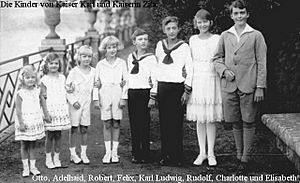
Charles's Death
Charles had been unwell for some time. After a shopping trip, he got bronchitis, which quickly turned into pneumonia. There was not enough medical care available. Zita, who was eight months pregnant, helped nurse him and their sick children. Charles died on April 1, 1922, at just 34 years old. His last words to Zita were, "I love you so much."
At his funeral, people admired Zita's strength. She did not lose her composure and greeted everyone who helped. Zita wore black for Charles for the rest of her life, which was 67 years.
Widowhood and Later Life
After Charles's death, Zita and her children moved again. The King of Spain, Alfonso XIII of Spain, helped them move to Spain. They arrived in Cadiz and were taken to a palace in Madrid. Soon after, Zita gave birth to her eighth child, Archduchess Elisabeth. Alfonso XIII offered them a palace in Lekeitio, Spain. Zita lived there for six years, focusing on raising and educating her children. They had limited money, living mainly on income from private property.
Move to Belgium
By 1929, some of Zita's children were ready for university. The family moved to Belgium to be closer to relatives. Zita continued to work for the Habsburg family's return to power. There was a chance for the Habsburgs to return to Austria, but this ended when Nazi Germany took over Austria in 1938. The Habsburg family resisted the Nazis, but their efforts failed.
Escape to North America
When the Nazis invaded Belgium in May 1940, Zita and her family became refugees. They narrowly escaped a bombing and fled to France, then to the Spanish border. They eventually reached Portugal. The U.S. government gave them visas, and they arrived in New York City on July 27. They lived with family in Long Island and New Jersey.
The family then settled in Quebec, Canada, because it was French-speaking. Money was very tight. Zita even had to make food from dandelion leaves. All her sons helped with the war effort. Otto met with Franklin Roosevelt, the U.S. President. Robert was a Habsburg representative in London. Carl Ludwig and Felix joined the United States Army. Rudolf secretly went to Austria to help the resistance. In 1945, Zita celebrated her birthday on the first day of peace. For the next two years, she traveled in the U.S. and Canada to raise money for Austria and Hungary.
Post-War Years
After the war, Zita often returned to Europe for her children's weddings. In 1952, she moved to Luxembourg to care for her aging mother. Her mother died in 1959 at 96. Zita then moved to a castle in Zizers, Switzerland. It had enough space for her large family and a chapel, which was important for her faith.
In her final years, Zita focused on her family. She was unable to attend her daughter Adelheid's funeral in 1972 because of rules about Habsburgs entering Austria. She also worked to have her husband, the "Peace Emperor," made a saint. In 1982, the rules changed, and she returned to Austria after 60 years. She visited her former homeland several times and even appeared on Austrian television.
Death and Burial
After her 90th birthday, Zita's health began to fail. She developed cataracts in both eyes. Her last big family gathering was her 95th birthday in 1987. In 1988, she got pneumonia and was bedridden. In early March 1989, she told her son Otto she was dying. Her family gathered by her side. She died on March 14, 1989, at 96 years old. She was the last surviving child of Robert, Duke of Parma.
Her funeral was held in Vienna on April 1. The government allowed it if the Habsburgs paid the costs. Zita's body was carried to the Imperial Crypt in the same funeral coach she had followed during Emperor Franz Joseph's funeral in 1916. Over 200 family members attended, along with politicians and church leaders. Following an old custom, Zita asked for her heart to be placed in an urn at Muri Abbey in Switzerland, where her husband's heart had rested for decades. This way, they would remain together.
At the crypt gates, the herald announced her as "Zita, Her Majesty the Empress and Queen."
Becoming a Saint
| Servant of God Zita of Austria-Hungary |
|
|---|---|
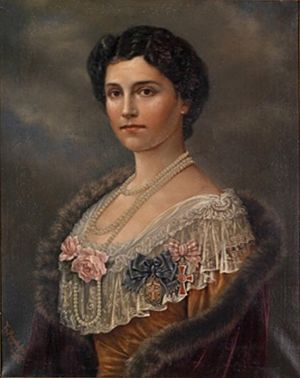
Empress Zita of Austria painted by Theodor Mayerhofer, circa 1917.
|
|
| Venerated in | Catholic Church |
| Feast | 21 October |
On December 10, 2009, the process to make Zita a saint began in France. Zita used to spend several months each year at a convent in France where three of her sisters were nuns.
Because this process has started, Empress Zita is now called a Servant of God.
Children of Zita
Charles and Zita had eight children. They also had many grandchildren and great-grandchildren.
| Name | Birth | Death | Notes |
|---|---|---|---|
| Crown Prince Otto von Habsburg | November 20, 1912 | July 4, 2011 | married Princess Regina of Saxe-Meiningen and had seven children. |
| Archduchess Adelheid | January 3, 1914 | October 2, 1971 | never married. |
| Robert, Archduke of Austria-Este | February 8, 1915 | February 7, 1996 | married Princess Margherita of Savoy-Aosta and had five children. |
| Archduke Felix of Austria | May 31, 1916 | September 6, 2011 | married Princess Anna Eugenie von Arenberg and had seven children. |
| Archduke Carl Ludwig | March 10, 1918 | December 11, 2007 | married Princess Yolanda of Ligne and had four children. |
| Archduke Rudolf | September 5, 1919 | May 15, 2010 | married Countess Xenia Tschernyschev-Besobrasoff (first) and Princess Anna Gabriele of Wrede (second). He had five children. |
| Archduchess Charlotte | March 1, 1921 | July 23, 1989 | married Duke Georg of Mecklenburg. |
| Archduchess Elisabeth | May 31, 1922 | January 6, 1993 | married Prince Heinrich of Liechtenstein and had five children. |
See also
 In Spanish: Zita de Borbón-Parma para niños
In Spanish: Zita de Borbón-Parma para niños




